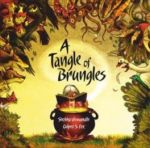
Farmer Falgu is off to the market to sell his produce, but has some unexpected bumps along the way. But then, Farmer Falgu can usually find his way out of any mess!
Materials from Asia

Farmer Falgu is off to the market to sell his produce, but has some unexpected bumps along the way. But then, Farmer Falgu can usually find his way out of any mess!

After the end of the Vietnam War, Van wakes up one morning to find that her mother, sisters, and brother are gone. They have escaped the new communist regime that has taken over Ho Chi Minh City for freedom in the West. Van is too young–and her grandmother too old–for such a dangerous journey by boat, so the two have been left behind. Once settled in North America, her parents will be able to sponser them, and Van and her grandmother will fly away to safety. But in the meantime, Van is forced ot work hard to satisfy her aunt and uncle, who treat her like an unwelcome guest. And at school she must learn that calling attention to herself is a mistake, especially when the bully who has been tormenting her turns out to be the son of a military policeman.

In Pakistan, Amal holds onto her dream of being a teacher even after becoming an indentured servant to pay off her family’s debt to the wealthy and corrupt Khan family.
Featured in WOW Review Vlume XI, Issue 2.

On April 1, 1945 with the battle of Okinawa beginning, fourteen-year-old native Okinawan Hideki, drafted into the Blood and Iron Student Corps, is handed two grenades and told to go kill American soldiers; small for his age Hideki does not really want to kill anyone, he just wants to find his family, and his struggle across the island will finally bring him face-to-face with Ray, a marine in his very first battle and the choice he makes then will change his life forever.
Featured in WOW Review Volume XI, Issue 2.

Jason has just learned that his Afghan mother has been living illegally in the United States since his father was killed in Afghanistan. Although Jason was born in the US, it’s hard to feel American now when he’s terrified that his mother will be discovered — and that they will be separated. When he sees his mother being escorted from her workplace by two officers, Jason feels completely alone. He boards a train with the hope of finding his aunt in New York City, but as soon as he arrives in Penn Station, the bustling city makes him wonder if he’s overestimated what he can do. After an accident lands him in the hospital, Jason finds an unlikely ally in a fellow patient. Max, a whip-smart girl who wants nothing more than to explore the world on her own terms, joins Jason in planning a daring escape out of the hospital and into the skyscraper jungle — even though they both know that no matter how big New York City is, they won’t be able to run forever.

Every night, when the owl hoots and the shadows of the trees dance on the walls, the Night Monster creeps into Avi’s room and frightens him. One day, his sister suggests he write a letter to the monster, and Avi’s nights are not the same any more.

To conjure up the charming Mr. Brungle, a coven of witches stirs up the Great Brungle Brew. For this, they toss in a lounge of lizards, a mischief of mice, and a quiver of cobras, among many others. Do they succeed? The book is a hilarious twist on collective nouns.

Discover the history of one of the world’s most influential civilizations. Based on the Cyrus Tang Hall of China exhibit at The Field Museum, China: A History traces the 7,000-year story of this diverse land. Full-color maps, photos, and illustrations of the people, landscape, artifacts, and rare objects bring the history of this nation to life! Young readers learn about prehistoric China, follow the reign of emperors and dynasties, and come to understand how China became the world power that it is today. The book also explores the role of children and women in everyday life as well as how religion, politics, and economics shaped the deep traditions and dynamic changes of modern China. This book stands alone from the exhibition and is a go-to resource for young readers looking to learn more about this powerful nation. It includes a timeline, bibliography, and index.

On a funny little vignette comes a cool-as-a-cucumber cow who introduces the readers to drama capturing the bovine and boisterous as everyone tries to unseat her highness.

In this book without words, a boy opens a door and invites the reader to explore the magical world on the other side.